Introduction
Oligosaccharides are a group of carbohydrate polymers containing 3 to 10 simple sugars that can be fed to pigs as prebiotics. Mannan- (Davis et al., 2002;3 Rozeboom et al., 20054 ), chito- (Liu et al., 20085 ), and fructo-oligosaccharides (Gebbink et al., 19996 ), have been shown to improve growth performance in young pigs. Possible mechanisms by which oligosaccharides benefit growth performance have been proposed and center on improving health status of the pig. For example, oligosaccharide may interact with intestinal mucosa and prevent pathogens, e.g., E. coli and Salmonella, from colonizing and proliferating at the mucosal surface (Miguel et al., 20047 ). Oligosaccharide may also enhance the immune system of pigs by increasing antibody titers, immunoglobulins, and macrophage activities (Davis et al., 20048 ). In addition, antibiotics have been widely fed to nursery pigs as growth promoters; however, concerns with antibiotic resistance have led to a ban on the use of growth promoting antibiotics that are medically important for human use (FDA, 20159 ) in swine diets. Therefore, oligosaccharide products have been proposed as the alternatives to antibiotics in nursery pig diets. The objective of this study was to determine the effects of feeding a gluco-oligosaccharide with or without a feed grade antibiotic on growth performance of nursery pigs.
Procedures
The Kansas State University Institutional Animal Care Committee approved the protocol used in the experiment. The study was conducted at a commercial nursery research facility in southwest Minnesota. The barn was mechanically ventilated and temperature was maintained at approximately 80°F. Each pen (12.1 × 7.5 ft2 ) had completely slatted plastic floors and was equipped with a 6-hole, stainless-steel, dry self-feeder and a pan waterer. Pigs were allowed ad libitum access to feed and water throughout the experiment. Diets were manufactured at a local feed mill (New Horizon Farms, Pipestone, MN). Feed additions to each individual pen were delivered and recorded by a robotic feeding system (FeedPro; Feedlogic Corp., Wilmar, MN).
This experiment was replicated twice. In replicate 1, pigs (n = 2,376; initial BW = 11.9 lb; PIC L337 × 1050) were housed in two rooms (48 pens in room 1 and 40 pens in room 2). Replicate 2 was conducted with the next group of pigs placed into room 1, but will be referred to as room 3 for ease of clarification. In room 3, pigs (n = 1,080; initial BW = 13.5 lb; PIC L337 × 1050) were housed in 40 pens. In each room, pens of pigs (27 pigs/pen) were blocked (6, 5, and 5 blocks in rooms 1, 2, and 3, respectively) by initial pen BW and allotted randomly to 1 of 8 dietary treatments. The dietary treatments were arranged in a 2 × 3 factorial, with or without antibiotic (0 or 55 ppm Carbadox, Phibro Animal Health Corp., Teaneck, NJ), and 4 levels of gluco-oligosaccharide (0, 200, 400, and 600 ppm; Midori USA, Inc., Cambridge, MA). The basal diets used in the study are provided in Table 1. Antibiotic and/or gluco-oligosaccharide were added to the basal diets at the expense of corn. The 0 and 600 ppm gluco-oligosaccharide diets were manufactured and used to blend in the robotic feeding system to provide diets with 200 and 400 ppm gluco-oligosaccharide (Table 2). Gluco-oligosaccharide product used in rooms 1 and 2 originated from a different batch from that of product used in room 3. Pigs were fed in 2 phases from d 0 to 14 and d 14 to 42. Pens were weighed and feed disappearance was measured every 7 d to determine ADG, ADFI, and F/G. Diet samples were taken from six feeders per dietary treatment, delivered to Kansas State University Swine Laboratory, and stored at -20°C. Diet samples were submitted to Ward Laboratories, Inc. (Kearney, NE) for analysis of DM, CP, crude fat, Ca, and P. Diet samples were also sent to Phibro Animal Health Corp. Feed Laboratory (State College, PA) for the analysis of Carbadox concentrations.
Data were analyzed using the GLIMMIX procedure of SAS (SAS Institute, Inc., Cary, NC) with pen as the experimental unit. The statistical model included fixed effects of room, antibiotic, gluco-oligosaccharide, and their interactions, with block as a random effect. The statistical model was simplified by removing the room × antibiotic × glucooligosaccharide interaction (P > 0.10), and the degrees of freedom of non-significant interactions were pooled to test the remaining fixed effects. Linear and quadratic contrasts were conducted among the gluco-oligosaccharide concentrations and a single degree of freedom contrast was used to compare the treatments with and without antibiotic. Results were considered significant at P < 0.05 and a tendency at 0.05 < P < 0.10.
Results and Discussion
Analyzed chemical composition of dietary treatments generally matched formulated nutrient levels. Analyzed CP and antibiotic concentrations were slightly lower than the formulated levels, but were consistent across treatments, phases, and rooms.
The P values for the fixed effects on ADG, ADFI, F/G, and BW are shown in Table 3. No room × antibiotic × gluco-oligosaccharide interactions were significant (P > 0.10) for any of the growth responses and, therefore, were removed from the statistical model. Tendencies for room × gluco-oligosaccharide interactions were observed for final BW (P = 0.059; Figure 1) and overall ADG (P = 0.087; Figure 2). Pigs from rooms 1 and 2 had similar response trends to the gluco-oligosaccharide but shared different patterns than that of pigs in room 3 (Figure 1 and 2). Pigs from the first (room 1 and 2) and second (room 3) replicates of the experiment were from different batches, raised in different time points, and fed a different batch of the gluco-oligosaccharide, which might explain the discrepancy in pig performance between experimental replicates. Therefore, data from room 1 and 2 were pooled to test the treatment effects of gluco-oligosaccharide and antibiotic separately from room 3.
No interactive effects among room, antibiotic, and gluco-oligosaccharide were observed for removal rate (P > 0.42). Percentage of pigs removed from the experiment was not affected by the antibiotic or gluco-oligosaccharide treatments, but tended (P = 0.064) to vary among rooms. Removal rate in room 3 (4.2%) was greater (P < 0.05) than in room 2 (1.9%), but was not statistically different from that in room 1 (2.8%); no differences were observed between removal rates in room 1 and 2.
No antibiotic × gluco-oligosaccharide interactions were observed in the analyses of growth responses. In a review of 29 studies, Miguel et al. (20047 ) concluded that the effects of feeding mannan-oligosaccharide on growth performance of nursery pigs were independent to the application of an antibiotic in the diet, and the effects are additive. Growth performance of pigs fed in rooms 1 and 2 is presented in Table 4. Body weight of pigs fed antibiotic was greater (P = 0.073) at d 14 and (P < 0.01) at d 28 and 42. Feeding an antibiotic improved (P = 0.026) ADG, tended to increase (P = 0.067) ADFI, but did not affect F/G of pigs from d 0 to 14. Pigs fed diets containing antibiotic had improved (P < 0.05) ADG, ADFI, and F/G compared with those fed diets without antibiotic from d 14 to 28 and 28 to 42. For the overall feeding period (d 0 to 42), ADG and ADFI were improved (P < 0.01), but F/G was unaffected by addition of a dietary antibiotic.
In rooms 1 and 2, increasing gluco-oligosaccaride increased (linear, P < 0.01) BW on d 14, 28, and 42. Increasing gluco-oligosaccharide improved (linear, P < 0.01) ADG and F/G, but did not affect ADFI from d 0 to 14. From d 14 to 28, increasing glucooligosaccharide increased (linear, P = 0.047) ADG and tended to increase (linear, P = 0.087) ADFI, but had no effect on F/G. Growth performance of pigs from d 28 to 42 were not affected by added gluco-oligosaccharide. For the overall period (d 0 to 42), increasing gluco-oligosaccharide improved (linear, P < 0.01) ADG and F/G and tended to increase (linear, P = 0.063) ADFI. Improved pig growth performance during nursery phases has been reported in other studies (Davis et al., 2002;3 Rozeboom et al., 2005;4 Liu et al., 20085 ) when mannan- or chito-oligosaccharides were added in the diets. Miguel et al. (20047 ) suggested that pigs in the first 1 to 2 weeks post-weaning with relatively slow growth rate had more prominent response to oligosaccharide products than older nursery pigs, which supported our findings that gluco-oligosaccharide treatment promoted ADG and F/G during d 0 to 14 and increased ADG and ADFI from d 14 to 28 but did not affect growth responses from d 28 to 42.
Growth performance of pigs in room 3 is presented in Table 5. Neither the antibiotic nor gluco-oligosaccharide treatments affected the BW of pigs. In contrast to the observations in rooms 1 and 2, a much smaller response was observed for dietary antibiotic addition in room 3, with the only improved (P = 0.005) F/G from d 14 to 28 and increased (P < 0.05) ADG and ADFI from d 28 to 42. No response was observed for added gluco-oligosaccharide, except that pigs tended (linear, P < 0.10) to have decreased ADG and ADFI from d 14 to 28 with increasing gluco-oligosaccharides. Discrepancies in pigs’ responses to gluco-oligosaccharide treatment between experimental replicates might be attributed to the environment, health status of pigs, quality of dietary ingredients, as well as many other factors (Miguel et al., 20047 ). Rozeboom et al. (20054 ) also reported inconsistent responses of pigs to dietary mannan-oligosaccharide in an experiment where improved ADG, ADFI, and F/G were observed in one research farm, but these responses were not able to be replicated in another two farms during the same feeding period; likewise, antibiotics were reported to enhance pig growth performance in two out of the three farms, but no effect was observed in the third farm.
In summary, these results suggest that the gluco-oligosaccharide used in these studies may improve growth performance of nursery pigs, especially during the early postweaning period, and the magnitude of these effects may be related to the concentration of gluco-oligosaccharide and independent to the use of antibiotic in the diets. However, further research is required to confirm the consistency of pigs’ responses to antibiotic and gluco-oligosaccharide treatments.
This article was originally published in Kansas Agricultural Experiment Station Research Reports: Vol. 2: Iss. 8. https://doi.org/10.4148/2378-5977.1295. This is an Open Access article licensed under a Creative Commons Attribution 4.0 License. 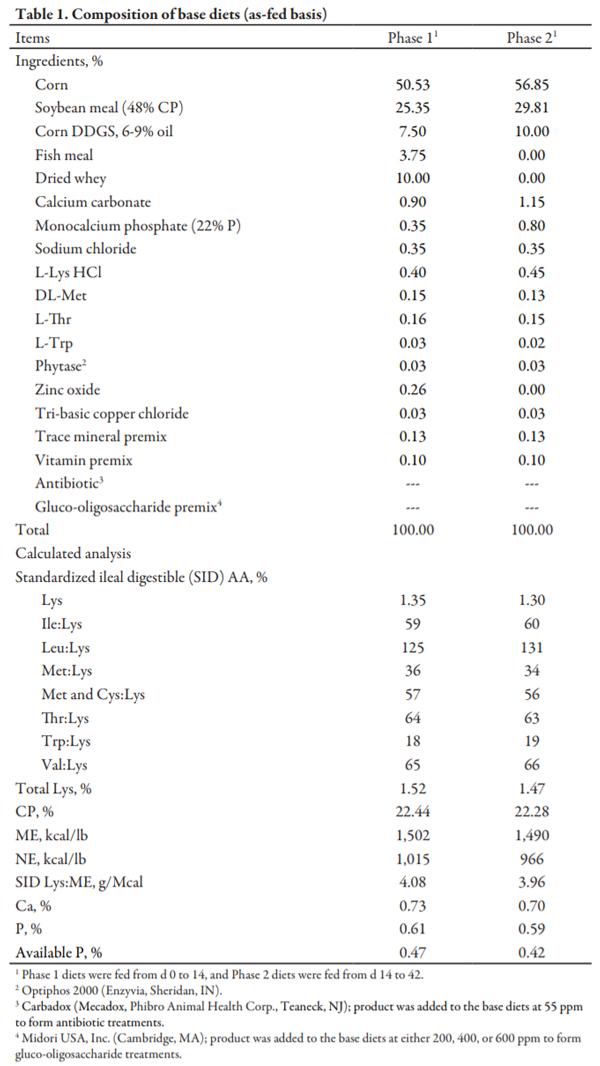
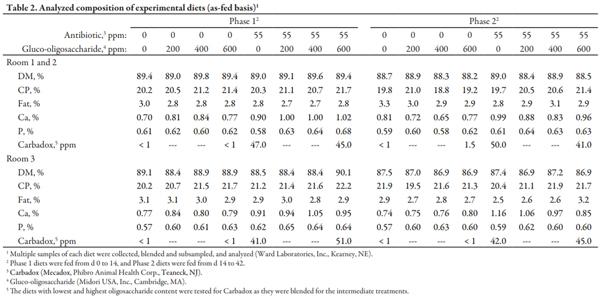
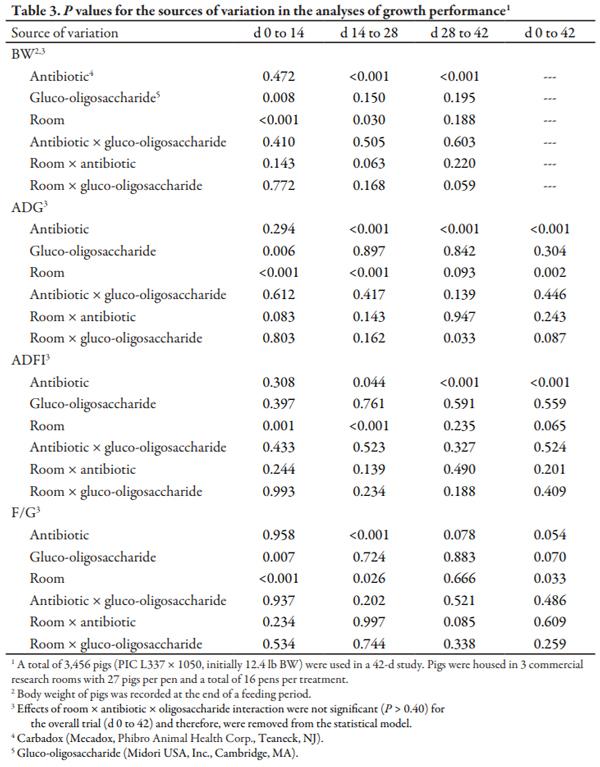

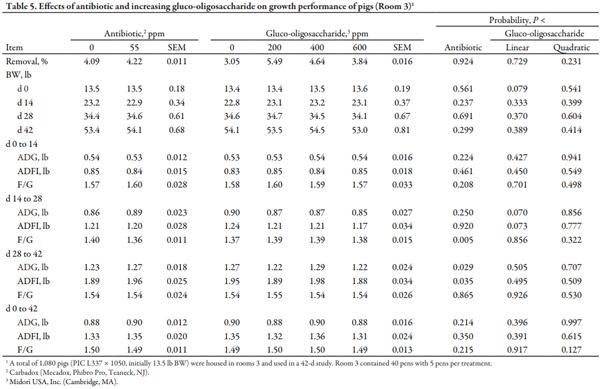

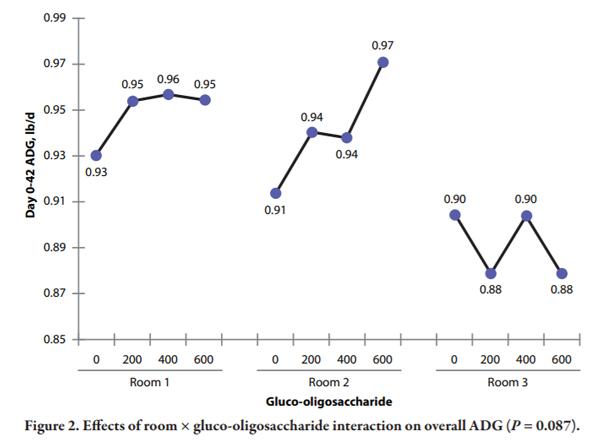











.jpg&w=3840&q=75)